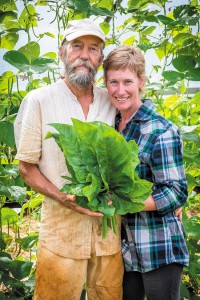Growing Organic Tahitian Taro
Lisa Fuller and husband Sun operate a biointensive farm called Kimu Aina and market organic produce under the name One Song Farm. Sun has been an organic farmer on Kauai for more than 24 years, and the couple has farmed together for six years.I will always remember my first interview with them at their farm in Moloaa.
“Are you really an organic farmer?” I asked skeptically. “A sign of organic produce is holes in the leaves. Your produce has no holes!”
A slow smile spread across Sun’s face, and he said, “When you have a banquet in the soil, the bugs don’t eat the plants.”
Sun is sharing this knowledge with the University of Hawaii in an effort to encourage gardeners and farmers to give up pesticides and grow organically.
On Sunday, Oct. 27, from 9 to 11 a.m., the couple will teach “Sustainable Island Tastes from the Garden.” Lisa will share biointensive farming techniques, and Sun will discuss unique challenges when growing food on Kauai. The workshop ends with a tasting of foods that grow easily on Kauai (including Tahitian taro) and recipes. The class costs $36 per person. For reservations, call 635-3020.
What’s Growing:Arugula, avocado, beets (red, golden, Lutz), bok choy, bananas, cabbage, carrots, chard, chives, cilantro, daikon, dasheen, eggplant (ping tung, ua poni), escarole, Ethiopian kale, green beans, ice cream bean, kai choy, kaffir lime, lemons, lemon-grass, lettuce (nine varieties including three romaines), limes, malabar spinach, multiplier onions, noni, opu squash, pak choi, papaya, parsley, perpetual spinach, radishes (red), rollinia, rosemary, shallots, Tahitian spinach, taro (more than 36 Hawaiian varieties), tat soi, thyme, won bok.
TAHITIAN TARO
Leaves and stalks of Xanthosoma brasiliense, also known as Tahitian taro, Tahitian spinach, tannier spinach, belembe and calalou, are cooked and eaten as a vegetable. Like taro, it is in the arum family, but is not a true Hawaiian taro. In Hawaii, Tahitian taro or Tahitian spinach was introduced from Tahiti before 1933 by the late G. P. Wilder. Although the scientific name would indicate that the plant is from Brazil, it is a native of the West Indies, where its common name is belembe.
With wide, spear-shaped leaves about 26 inches in diameter on stalks that grow up to 3 feet high, the plant makes an attractive addition to an edible landscape.
Season: The perennial’s first harvest can be after six to eight weeks. Plant in a rich, damp, organic soil to grow well. It does well in flooded or poorly drained areas where other crops cannot grow.
What to look for: Sun and Lisa sell leafy stems in a “bouquet.” Leaves may wilt from heat, but will revive with a dip in cool water.
Storage: Store whole in a plastic bag in the refrigerator. To make room, cut stems at the base of the leaf, stack leaves, tuck stems alongside and store in the refrigerator for up to one week.
Preparation: The corm is too small for use, but sturdy leaves can be used in place of taro leaves. Both Hawaiian and Tahitian taro contain calcium oxalate, which must be cooked out. Calcium oxalate will not kill you, but the burning, itchy sensation in your mouth and throat can make you feel like you are dying. Hawaiian taro leaves can take up to 60 minutes to fully cook, but Tahitian taro contains small amounts and need only be cooked for about 10 minutes.
Dice and sauté stems and serve as a side dish or in soups. Their creamy insides make a pleasing addition to meals. Use leaves as you would any green or as a wrap for steamed lau lau. It is one of several leafy vegetables used to make callaloo, a popular dish in the Caribbean. Rodman Machado, executive chef at The Garden Cafe, makes a “lazy man” lau lau stew with pork and Tahitian taro leaves. These greens are mild in flavor and are excellent additions to stir-fries, stuffings, soups and stews.
Health benefits: Belembe is a valuable leafy green vegetable because of its high nutritive value and because it can easily grow in home gardens year round. It is a good source of niacin, vitamin B6, iron and manganese, and a very good source of vitamin A, vitamin C, riboflavin, calcium, magnesium and potassium. One cup (125 grams) contains 3 grams of protein.
One Song produce can be found at: Farmers Markets: Namahana (Saturdays, 9 a.m. to noon). Restaurant: The Garden Cafe. Grocery: Healthy Hut, Papaya’s Natural Foods & Cafe. For workshop reservations, call Lisa at 635-3020.
RODMAN’S TAHITIAN LUAU EMPANADAS
Rodman Machado made these for a recent catering job, which is a service The Garden Cafe offers. He made the pastry dough, but you can replace it with any type of wrapper such as those for won tons or egg rolls. Makes 1 dozen.
* 1 pound Tahitian taro leaves, cleaned, stemmed and chopped
* 1 cup roasted kabocha squash pulp
* 2 cups brown rice, cooked and cooled
* 1 onion, diced
* 2 garlic cloves, minced
* 1 tablespoon organic canola oil
* 2 cups water
* 1 teaspoon salt
* freshly ground pepper, to taste
Warm oil in a large pot over medium heat and add onions, garlic and salt. Cover, turn heat to medium-low and sweat onions until translucent, about 5 minutes. Add Tahitian taro leaves and water and cook until tender, about 10 minutes. Cool to room temperature. In a bowl, combine pumpkin, brown rice and 1 cup taro leaf mixture. Stir to combine and season to taste. Place one tablespoon of mixture on a corner of the won ton wrapper, leaving a 1/2-inch border. With your finger, wet two sides of the wrapper’s edge with water. Fold wrapper over mixture and press edges so they seal. Bake or fry until golden brown.




